We have been dealing with invasive species since humans starting transporting goods across land and sea. Many species that we think of as natives might just be an original hitchhiker from a long time ago. Sometimes these things happen by accident when something snags a ride with an unsuspecting host or species are brought in on purpose. Why are invasives such a problem? Well, when a species is introduced to a new area, it usually has all the advantages in the world. They are likely to not have any predators and that provides them the opportunity to eat, populate quickly, and encroach on other's habitats. By the time all the original habitants catch up on who the new species is, the new guys have already established themselves and have depleted much of the area's resources.
In Colorado, we have been lucky to not be plagued with the aquatic invasives that the Great Lakes area has seen, but with increased tourism and boating the state is becoming more worried about an unstoppable outbreak of the invasive species. Testing is done regularly on Colorado's bodies of water and there have been positive results for mussels. New legislation has been making its way through the State Senate and House entitled the Mussel Free Colorado Act HB18-1008, with hopes to combat the fast-spreading is invasive mussels.
[1] Zebra and quagga mussels pose a great ecological and financial threat to the state. The invasion of these mussels can affect every Coloradoan and visitors in some way and the impacts could be devastating. Potential impacts include:
- Prolific reproduction
- Clog water infrastructure
- Ecological impacts
- Recreational impacts
- Economic impacts
- Social impacts
- Difficult or impossible to eradicate
- Quick spread to new waters
[2] Both adult zebra mussels and the larval form, known as veligers, can be transported into other bodies of water. Adult zebra mussels can attach to boats or other equipment and be transported to new waters.
Adult zebra mussels are able to close their shell and may survive out of water for several days.
Veligers (larval zebra mussels) are able to hitchhike in water held in the bilge, live wells, motors, or bait buckets, or they may cling to plant fragments, boats or trailers, or other equipment or recreational items that came into contact with water.
You can’t always see zebra mussels because the larvae are invisible to the naked eye. They can survive for days in water trapped in a boat. The only way to be sure you’re not carrying zebra mussels to another body of water is to always Clean - Drain - Dry your boat, trailer, and gear. To minimize the potential spread of zebra mussels, follow these simple steps:
- CLEAN: your boat, trailer and gear by removing all plants, animals and foreign objects.
- DRAIN: all water from the boat, including the motor, bilge, live wells and bait buckets, before leaving the lake.
- DRY: boat, trailer and gear at least 5 days before entering another water body. If unable to let it dry for at least 5 days, rinse equipment and watercraft (with high pressure, hot water when possible) and wipe with a towel before reuse.
- DISPOSE of unwanted live bait and worms in the trash.
- NEVER introduce fish, plants, crayfish, snails or clams from one body of water to another.
Keep yourself updated about potential invasives threats in Colorado:













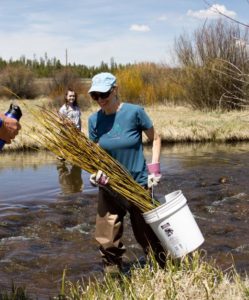 The group’s inaugural project at Fraser Flats aimed to restore a roughly one-mile stretch of the Fraser between the towns of Tabernash and Fraser, with the goal of providing healthy habitat for trout even during periods of reduced flows. The Fraser in this section had become too wide and shallow, resulting in sedimentation and high temperatures that smothered bug life and pressured coldwater-loving trout.
The group’s inaugural project at Fraser Flats aimed to restore a roughly one-mile stretch of the Fraser between the towns of Tabernash and Fraser, with the goal of providing healthy habitat for trout even during periods of reduced flows. The Fraser in this section had become too wide and shallow, resulting in sedimentation and high temperatures that smothered bug life and pressured coldwater-loving trout.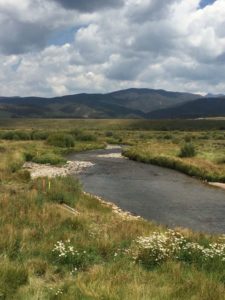 Colorado Parks and Wildlife conducted a fish survey on Oct. 5, shortly after completion of the project, and found dramatic increases in the biomass of brown and rainbow trout in the stretch compared to previous surveys, and an even larger increase in numbers of larger (14" and up) fish.
Colorado Parks and Wildlife conducted a fish survey on Oct. 5, shortly after completion of the project, and found dramatic increases in the biomass of brown and rainbow trout in the stretch compared to previous surveys, and an even larger increase in numbers of larger (14" and up) fish.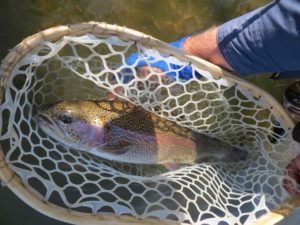
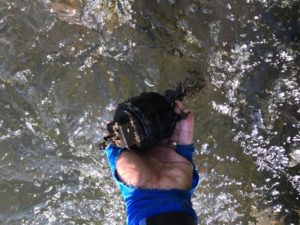
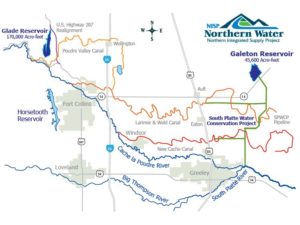 The
The 
